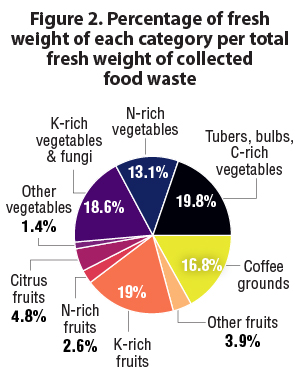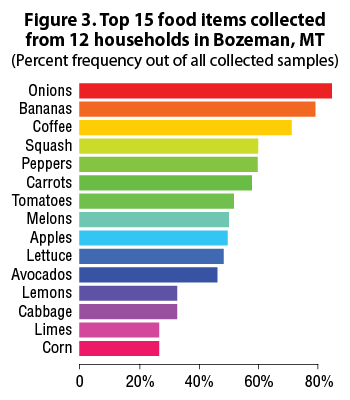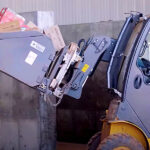Top: Household biodigester unit supplied by HomeBiogas will be installed at some homes participating in the pilot project. Photo by Elizabeth Reiva
E. Reiva, G. Abel, R. Ebel, J. Eberly and F. Menalled
According to the U.S. EPA’s 2018 Food Waste Report, residential sources account for 25% of food waste in the United States. Any municipality wishing to address this type of waste faces a difficult task. Not only is there a large amount of household food waste, there is a lot of variation within it.
Household biodigesters provide a means of managing food waste where it is generated. The biogas can be used for heat and energy while the biofertilizer improves soil health and crop yield via its nutrient content and its enhancement of the soil microflora, which distinguishes it from industrial fertilizers (Ebel & Kissmann, 2019). In recent years, foreign companies have been making biodigesters more easily available to individual households by offering small commercial units. This offers the exciting possibility of more households taking direct responsibility for the food waste they produce, lessening the burden on municipalities, particularly in cities — like Bozeman, Montana — that lack a public option for organic waste management.
The outputs generated by household biodigesters can provide benefits to users. However, the usefulness of these outputs and, by extension, the viability of household biodigesters, is determined by how well these installations can be utilized by those who install them. Feasibility can be affected by the inappropriate selection of the food waste placed into a biodigester, as well as variations caused by the placement of the biodigester outside and local temperature. Also, while farms are expected to consistently produce the same amount and sort of waste, household food waste is more unpredictable. This could make widespread use of household biodigesters not worth the difficulty of widespread installation. To enhance the use and adoption of biodigesters, our team at Montana State University in Bozeman is seeking to address the question of how well households can utilize them.
Biodigester Research Project
 In 2021, a research project was initiated to assess the biofertilizers generated by biodigesters used by individual households. The project involves distribution of two biodigester models to participating households: HomeBiogas (feature photo, above), and one designed by our research team (adapted from Figure 1). Twelve Bozeman households were selected out of a pool of 113 volunteers for this study. In 2022, households will use a biodigester to process their food waste into biofertilizer, which will be collected regularly and tested on a crop in a greenhouse setting to determine its effectiveness compared to conventional organic fertilizer.
In 2021, a research project was initiated to assess the biofertilizers generated by biodigesters used by individual households. The project involves distribution of two biodigester models to participating households: HomeBiogas (feature photo, above), and one designed by our research team (adapted from Figure 1). Twelve Bozeman households were selected out of a pool of 113 volunteers for this study. In 2022, households will use a biodigester to process their food waste into biofertilizer, which will be collected regularly and tested on a crop in a greenhouse setting to determine its effectiveness compared to conventional organic fertilizer.
The duration of the digestion process and the nutrient content of the biofertilizer are influenced by the types of food waste going into the biodigester. Therefore, it is essential to understand what sorts of food waste households generate. During 12 weeks in 2021, food waste was collected from the participating households to establish a baseline for each household’s food waste production and assign the appropriate biodigester model to each. Five-gallon buckets were distributed, along with instructions on what food waste was acceptable for collection.
Categories of acceptable food waste were: Carbon (C)-rich vegetables, tubers and bulbs (onions, potatoes, etc.); Nitrogen (N)-rich vegetables (lettuce, spinach, etc.); Potassium (K)-rich vegetables and fungi (squash, watermelon, etc.); other vegetables; citrus fruits (oranges, lemons, etc.); N-rich fruits (avocados, etc.); K-rich fruits (bananas, apples); other fruits; coffee grounds; bakery goods (bread, tortilla); dried foods and powders; and other acceptable food. Buckets were collected and weighed biweekly, providing a fresh weight of each category by household.
Food Waste Findings
 Over the 12 weeks of this portion of the study, a total of 304 lbs of food waste were collected, averaging 25.3 lbs/week (two-sided t-test, p-value <0.01 for the total weight). Out of all food waste categories, the C-rich vegetable category made up the plurality of the waste, followed by K-rich fruits and K-rich vegetables (Figure 2). Dried foods and powders, baked goods, and other acceptable foods were the least represented in the collected waste (<1% of the total waste). The most commonly collected individual foods were onions, which fall within the category of tubers, bulbs, and C-rich vegetables (Figure 3).
Over the 12 weeks of this portion of the study, a total of 304 lbs of food waste were collected, averaging 25.3 lbs/week (two-sided t-test, p-value <0.01 for the total weight). Out of all food waste categories, the C-rich vegetable category made up the plurality of the waste, followed by K-rich fruits and K-rich vegetables (Figure 2). Dried foods and powders, baked goods, and other acceptable foods were the least represented in the collected waste (<1% of the total waste). The most commonly collected individual foods were onions, which fall within the category of tubers, bulbs, and C-rich vegetables (Figure 3).
 While reducing the amount of edible food wasted is important, the question of what to do with the food scraps that will always be produced still remains. The data collected can be viewed through two different lenses. In the context of our study, it provides a useful benchmark for how much food waste we can expect each household to contribute, considering specific demographics. It also provides insight into what mixes of the different feedstocks will be generated by these households, which will impact the biofertilizer produced. Placed in the larger context of municipal food waste, these results give an intriguing insight into what an average household’s food waste looks like.
While reducing the amount of edible food wasted is important, the question of what to do with the food scraps that will always be produced still remains. The data collected can be viewed through two different lenses. In the context of our study, it provides a useful benchmark for how much food waste we can expect each household to contribute, considering specific demographics. It also provides insight into what mixes of the different feedstocks will be generated by these households, which will impact the biofertilizer produced. Placed in the larger context of municipal food waste, these results give an intriguing insight into what an average household’s food waste looks like.
This study collected food waste during the Spring and Summer, which may have affected the data. Food waste generated during a different season may have a different character. For instance, seasonal products such as watermelons would likely be found less during the Winter. A more thorough study into the food waste of households across municipalities with different population sizes and demographics could help to further improve and refine their waste treatment programs.
Elizabeth Reiva, Gracelyn Abel, Roland Ebel, Jed Eberly and Fabian Menalled are researchers at Montana State University.













